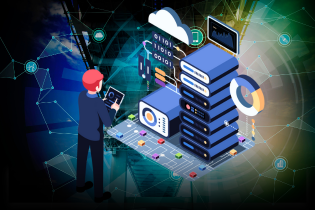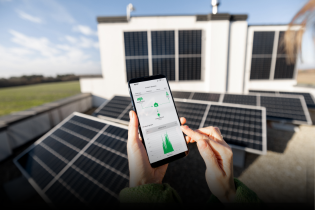In today’s interconnected world, precise temperature control is paramount across various industries. From ensuring the safety of pharmaceuticals to optimizing manufacturing processes and safeguarding critical infrastructure, accurate temperature monitoring is no longer a luxury but a necessity. This blog delves into the intricacies of temperature monitoring systems, exploring their significance, key components, and the transformative impact of IoT technology in this domain.
What is Temperature Monitoring?
Temperature monitoring involves the continuous measurement and recording of temperature within a specific environment or process. This critical data is then analyzed to ensure optimal conditions, prevent potential hazards, and maintain compliance with industry regulations.
The Role of Temperature Monitoring Across Industries
Healthcare
Vaccine Cold Chain: Maintaining the integrity of vaccines is crucial. IoT-enabled temperature monitoring systems ensure adherence to strict temperature guidelines, minimizing vaccine spoilage and maximizing public health impact.
Blood Banks: Precise temperature control is vital for blood storage, ensuring its safety and efficacy for transfusions.
Hospital Operations: Monitoring temperatures in operating rooms, incubators, and other critical areas is essential for patient safety and optimal healthcare delivery.
Food and Beverage
Cold Chain Management: Maintaining the cold chain throughout the entire food supply chain is paramount. IoT sensors monitor temperatures during transportation and storage, minimizing spoilage and ensuring food safety.
Food Processing: Accurate temperature control is crucial during various stages of food processing, including cooking, cooling, and packaging, to maintain quality and safety.
Manufacturing
Industrial Processes: Precise temperature control is essential for many manufacturing processes, ensuring product quality and preventing equipment damage.
Aerospace and Automotive: Maintaining specific temperature ranges is critical for the production of high-performance materials like metals and composites.
Machine Maintenance: Predictive maintenance strategies leverage temperature data to identify potential equipment failures before they occur, minimizing downtime and reducing maintenance costs.
Data Centers
Overheating can lead to equipment failures, data loss, and costly downtime. IoT-based temperature monitoring systems provide real-time data to optimize cooling systems, prevent overheating, and ensure uninterrupted operations.
Agriculture
Smart Agriculture: IoT sensors monitor soil temperature and humidity, providing valuable insights for optimizing irrigation, improving crop health, and maximizing yields.
Livestock Management: Maintaining optimal temperatures for livestock is crucial for animal health and productivity.
Key Features of Advanced Temperature Monitoring Systems
- Real-Time Monitoring: Continuous and instantaneous data acquisition for immediate insights and proactive responses to temperature deviations.
- Customizable Alerts: Configurable alerts via text messages, emails, or phone calls to notify users of critical temperature changes.
- Data Logging and Analysis: Comprehensive data logging and analysis capabilities to identify trends, identify anomalies, and ensure compliance with regulations.
- Wireless Connectivity: Enables remote monitoring and data access through Wi-Fi, cellular, or other wireless technologies.
- Battery Backup: Ensures uninterrupted operation during power outages to maintain critical temperature control.
- Smooth Integration: Seamless integration with existing systems, such as building management systems, HVAC systems, and inventory management software.
- User-Friendly Interface: Intuitive dashboards and easy-to-use interfaces for effortless system operation and data visualization.
Types of Temperature Monitoring Systems
Manual Temperature Monitoring Systems
Utilize traditional devices like thermometers for manual temperature readings.
Advantages: Cost-effective, low maintenance, no power dependency.
Limitations: Labor-intensive, prone to human error, no real-time monitoring.
Applications: Small-scale applications, household use, limited budgets.
Digital Temperature Monitoring Systems
Employ digital thermometers with displays for easy readout.
Advantages: Higher accuracy, ease of use, basic data logging capabilities.
Limitations: Limited connectivity, often require external power sources.
Applications: Laboratories, food storage facilities, basic industrial applications.
IoT-Based Temperature Monitoring Systems
Utilize interconnected sensors and devices for real-time data collection, analysis, and remote monitoring.
Advantages: Real-time monitoring, remote access, predictive maintenance, scalability, integration capabilities.
Limitations: Higher initial investment, dependency on reliable internet connectivity, potential complexity in setup and maintenance.
Applications: Healthcare, food and beverage, manufacturing, data centers, agriculture.
Selecting the Right Temperature Monitoring System
- Accuracy: Choose systems with high accuracy levels to ensure reliable data and prevent costly errors.
- Durability: Select systems designed to withstand harsh environmental conditions and operate reliably in challenging environments.
- Range of Operations: Ensure the system can accurately measure temperatures within the required range for your specific application.
- Connectivity Options: Prioritize systems with robust connectivity options, including Wi-Fi, cellular, and IoT integration.
- Battery Life and Power Backup: Ensure uninterrupted operation during power outages.
- Compliance and Certification: Select systems that comply with relevant industry standards and regulations (e.g., FDA, ISO 9001).
- Scalability: Choose a system that can easily adapt to your changing needs and scale as your business grows.
The Future of Temperature Monitoring
Advancements in IoT, AI, and machine learning are driving the evolution of temperature monitoring systems.
AI-powered Predictive Analytics: AI algorithms can analyze historical data to predict potential equipment failures and proactively address issues.
Edge Computing: Processing data closer to the source reduces latency and enables faster response times, critical for time-sensitive applications.
Blockchain Technology: Enhanced data security and transparency in the supply chain through tamper-proof records.
Conclusion
In today’s dynamic business landscape, reliable temperature monitoring is crucial for maintaining product quality, ensuring safety, and optimizing operations. IoT-enabled temperature monitoring systems are transforming the way businesses operate, providing real-time insights, enabling predictive maintenance, and driving operational efficiency.
Contact FSM Connect today to explore our cutting-edge IoT solutions and discover how we can help you implement a robust and effective temperature monitoring system for your specific needs.


